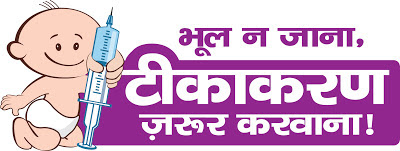Lack of awareness on routine immunisation, little or no knowledge on vaccine-preventable diseases, the need to reach out to some of the remote, high-risk districts in India to create demand for routine vaccination, has encouraged India to develop a holistic and integrated communication strategy on routine immunization. To be sure, the Indian government has declared 2012-2013 as the ‘year of intensification of routine immunisation’ in line with the World Immunisation Week 2013. What’s more, India has identified four rounds of special immunisation weeks in high-risk areas during the months of April, June, July and August.
With the aim to branding immunisation in a big way, so it can be visible in the minds of the people who are ignorant of its benefits, the Indian government through the Ministry of Health and Family Welfare, with the help of other stakeholders, including UNICEF and World Health Organisation (WHO), launched its unique communication strategy early this week that will roll out all over India in the next two-three months. This includes a new logo, television spot, radio jingle, besides posters informing people about the benefits of vaccines.
The logo is that of a chubby smiling baby in white diapers comfortably holding an injection in her hand, saying, “Don’t forget, vaccination your baby must get.” The television spot is that of indulgent family members gushing over a new-born baby who reminds them that they have to take her for routine vaccination and immunisation. The effect is evident: Even as adults temporarily forget the basic right for their child to live, survive and grow, the child reminds them to take her for routine vaccinations instead.
The logo, television and radio spots and posters were launched in New Delhi earlier this week by Anuradha Gupta, additional secretary, Ministry of Health and Family Welfare. Speaking on the occasion, Gupta spoke of the challenges of routine immunisation that still plague the country and why it is important to reinforce the message to the parents, many of whom are unaware of the benefits of these vaccinations. It is a dual challenge: reaching out to 2.7 crore new born children every year while also tracking the growth and vaccinating children up to five years (13-14 crore children every year by that yardstick) and educating parents on the advantages of giving their children routine vaccination.
The task is not easy, as UNICEF’s India Representative Louis-Georges Arsenault noted, especially given some shocking findings on reasons why people don’t immunise children: roughly 28 per cent of parents felt there was no need for it, 10.8 per cent had no idea where to go for vaccinations, 26 per cent had no idea they even existed, and roughly 8 per cent feared side effects because of myths and wrong information spread about routine immunisation. Arsenault noted that issues were restricted not just on demand but also supply side especially with vaccines not available in certain areas (6.2 per cent), services not available (2.1 per cent) and in some cases long waiting time (2.1 per cent) (Figures as per CES 2009 report). Arsenault also noted that the “last mile” was always challenging; even as DPT-3 coverage in India is roughly 72 per cent, 75 lakh children still await getting the dose.
Taking the micro-planning route, identifying the high-risk areas, marking priority districts, targeting urban slums and tracking the growth trajectory of children and mothers, besides rolling out the communication strategy is the way forward for the success of routine immunisation, according to the experts who were present at the event.
For a country that has eradicated polio fully for the last two years, the effort for routine immunisation needs to gather more force especially given alarming statistics of 8 million deaths of new born babies every year and 7.4 million kids still waiting for their vaccinations even as roughly 4 million lives of babies get saved every year.
The yawning gap needs to be filled. The routine immunisation communication strategy is the way forward and this is just the beginning.


No comments:
Post a Comment